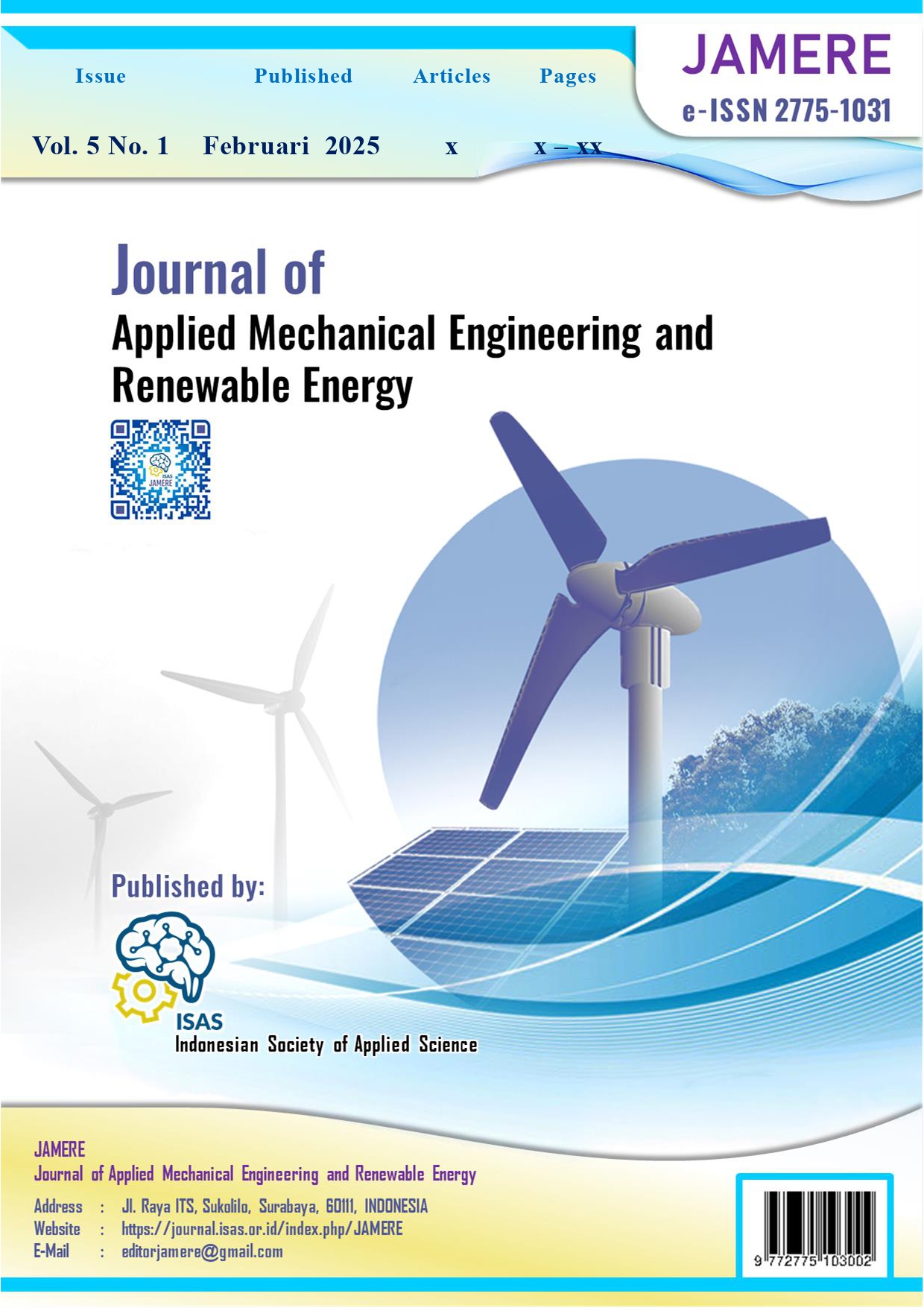Pengaruh Kapasitas Cavitation Air Flotation Terhadap Penurunan Total Suspended Solid Berdasarkan Baku Mutu Air Limbah di PT. X
DOI:
https://doi.org/10.52158/jamere.v5i1.1100Keywords:
limbah cair, Effluent Treatment Plant (ETP), Cavitation Air Flotation (CAF), Total Suspended Solid (TSS)Abstract
Effluent Treatment Plant (ETP) is an environmentally based regional waste treatment system that aims to treat liquid waste so that it can produce waste that meets quality standards. Liquid waste that cannot be treated properly can result in environmental pollution. The research methodology used is a method of observation study by direct observation including the processing process in the ETP plant, the data collected is calculated based on the parameters of liquid waste before and after processing. From the data, there are several days that show that only 80% of waste can be treated on ETP from the total waste sent from the production plant. This has an impact on the quality of TSS (Total Suspended Solid) parameters treated at CAF experiencing outspec of 20.79% of the operational standards of TSS parameters in PT X. Based on the results of research found that CAF (Cavitation Air Flotation) capacity is less maximal when the flowrate of waste to be treated is high so that the treatment capacity in ETP cannot keep up with the amount of waste sent from the production plant. This can cause the level in the accident pond and equalization pond high and eventually result in wastewater overflowing into the environment so from this analysis process is obtained the proposed improvement of the process to improve the performance of IPAL is to add CAF to the pre-treatment process.
References
[2] NURSANTI IDA, “Jurnal Ilmiah Universitas Batanghari Jambi Vol.13 No.4 Tahun 2013 KARAKTERISTIK LIMBAH CAIR PABRIK KELAPA SAWIT PADA PROSES PENGOLAHAN ANAEROB DAN AEROB Ida Nursanti 1,” J. Ilm. Univ. Batanghari Jambi, vol. 13, no. 4, pp. 67–73, 2013.
[3] A. M. Purba, M. W. Lestari, I. Imnadir, M. Sari, H. Silitonga, and J. Siburian, “Sistem Pendeteksian Air Limbah Cair Industri,” J. Darma Agung, vol. 32, no. 1, p. 483, 2024, doi: 10.46930/ojsuda.v32i1.4131.
[4] ARSI AMALIA, “Tesis Sebagai Salah Satu Syarat Untuk Mencapai Gelar Magister Program Studi Pengelolaan Lingkungan Hidup Disusun dan Diajukan oleh ARSI AMALIA,” 2021.
[5] A. Priyandes, “Penggunaan Water Recycle Untuk Kebutuhan Air Di Kawasan Industri Batam,” Dimensi, vol. 7, no. 3, pp. 654–672, 2018, [Online]. Available: http://repo.iain-tulungagung.ac.id/5510/5/BAB 2.pdf
[6] J. N. Saragih, “Analisa Data Hasil Pengolahan Limbah Cair Pt . Charoen Pokphand Indonesia Kawasan Industri Medan Skripsi Oleh : Jenny Natalia Saragih Fakultas Biologi Universitas Medan Area Medan,” no. Kim Ii, 2018.
[7] Y. Ashar Khairina, “Dasar Kesehatan Lingkungan,” Dasar Kesehat. Lingkung., p. 67, 2020, [Online]. Available: http://repository.uinsu.ac.id/8798/1/DIKTAT.pdf
[8] A. Farhan, C. C. Lauren, and N. A. Fuzain, “Analisis Faktor Pencemaran Air dan Dampak Pola Konsumsi Masyarakat di Indonesia,” J. Huk. dan HAM Wara Sains, vol. 2, no. 12, pp. 1095–1103, 2023, doi: 10.58812/jhhws.v2i12.803.
[9] M. F. Natsir, M. Selomo, and R. La Ane, “Efektifitas Drum Of Wastewater Treatment (DOWT) Dalam Mereduksi Kadar Phosphat Dan Nitrit Limbah Cair Domestik 2019,” J. Nas. Ilmu Kesehat., vol. 1, no. 69, pp. 1–16, 2019, [Online]. Available: journal.unhas.ac.id
[10] Muliari and I. Zulfahmi, “Dampak Limbah Cair Kelapa Sawit Terhadap Komunitas Fitoplankton di Sungai Krueng Mane Kabupaten Aceh Utara,” J. Perikan. dan Kelaut., vol. 6, no. 2, pp. 137–146, 2016, [Online]. Available: https://pdfs.semanticscholar.org/9ab4/51db5978aed65c5c3b406b9a9ef7d03fbb57.pdf
[11] G. J. Ratnawati, L. Triana, S. Lia, and M. Salim, “Pengaruh Lama Perendaman Arang Aktif Cangkang Kelapa Sawit Terhadap Kadar Cod (Chemical Oxygen Demand) Pada Limbah Cair Pabrik Kelapa Sawit,” J. Lab. Khatulistiwa, vol. 6, no. 1, p. 31, 2022, doi: 10.30602/jlk.v6i1.1125.
[12] Kementerian Lingkungan Hidup Republik Indonesia, “Peraturan Menteri Lingkungan Hidup Republik Indonesia,” Https://Jdih.Maritim.Go.Id/, pp. 1–83, 2014, [Online]. Available: https://jdih.maritim.go.id/en/peraturan-menteri-negara-lingkungan-hidup-no-5-tahun-2014
[13] E. Satiti, “Identifikasi Karakterisasi Limbah Cair Serta Evaluasi Instalasi Air LIMBAH (IPAL) Pasar Tradisional,” p. 171, 2011.
[14] B. Rahadi, R. Wirosoedarmo, and A. Harera, “Sistem Anaerobik-Aerobik pada Pengolahan Limbah Industri Tahu untuk Menurunkan Kadar BOD5, COD, dan TSS,” J. Sumberd. Alam dan Lingkung., vol. 5, no. 1, pp. 17–26, 2018, doi: 10.21776/ub.jsal.2018.005.01.3.
[15] M. Fikri, “Penggunaan Teknologi Clarifier Tank pada Pengolahan Kelapa Sawit,” Pros. Semin. Nas. Lahan Suboptimal, pp. 803–810, 2021.
















